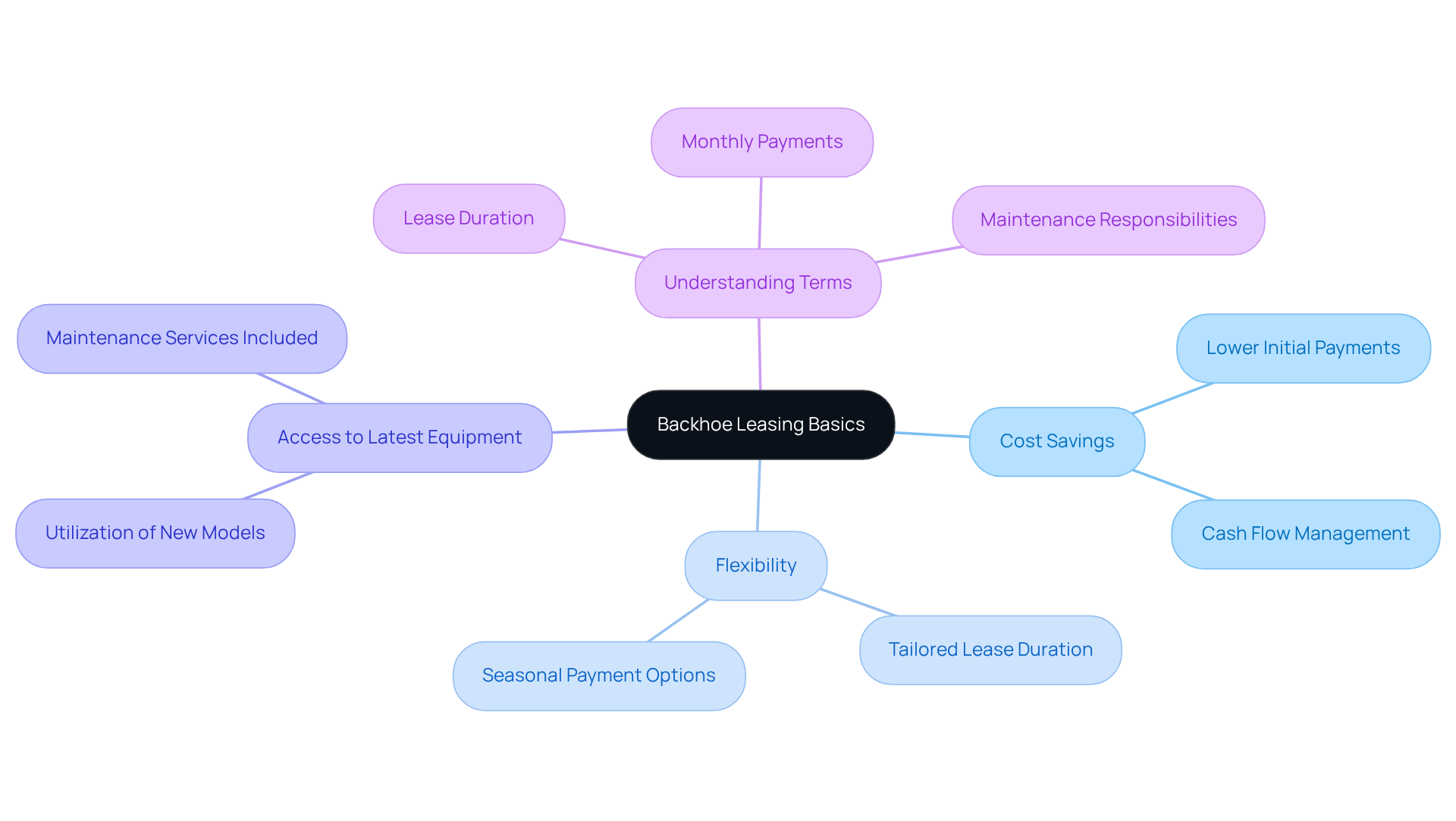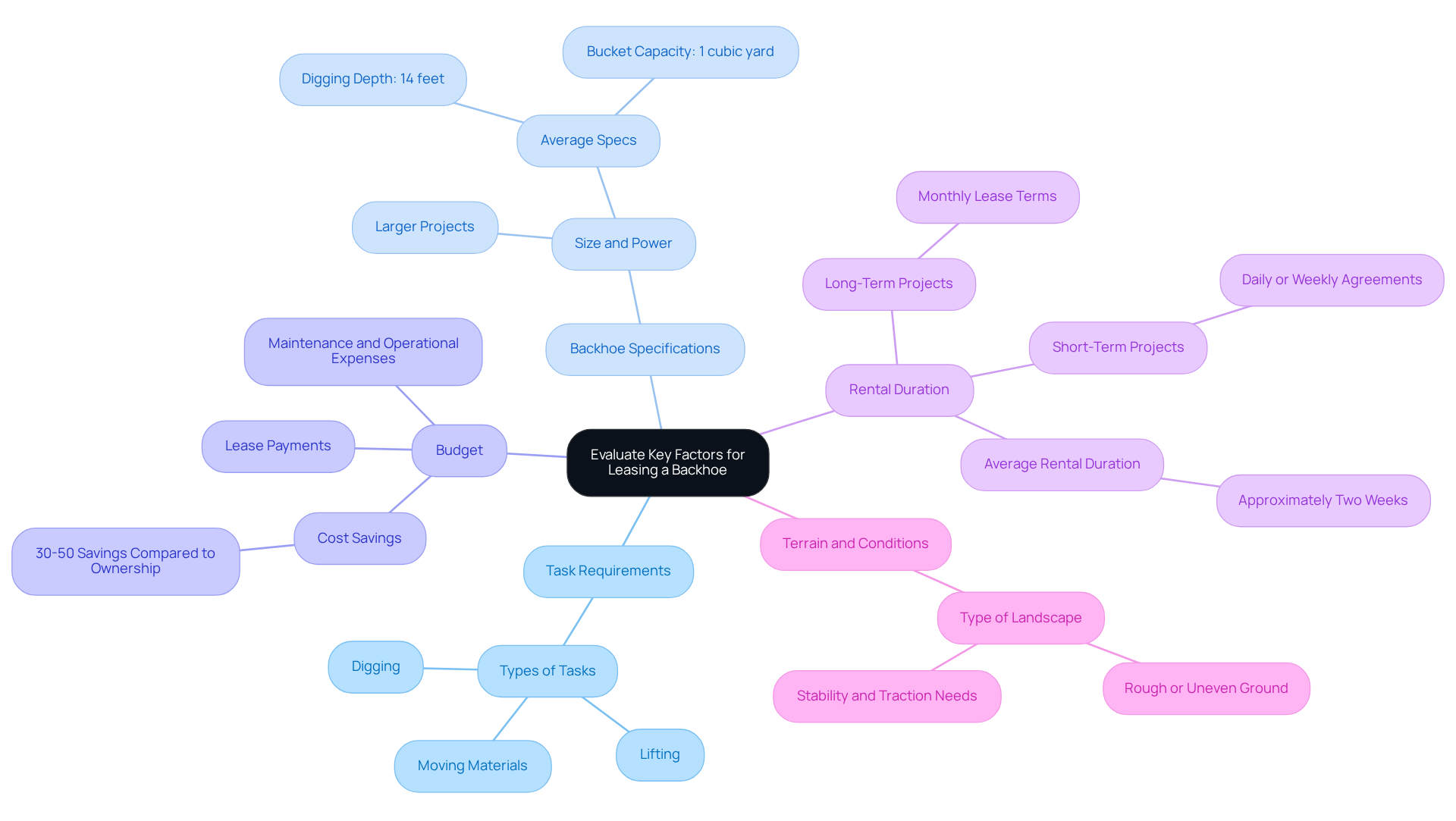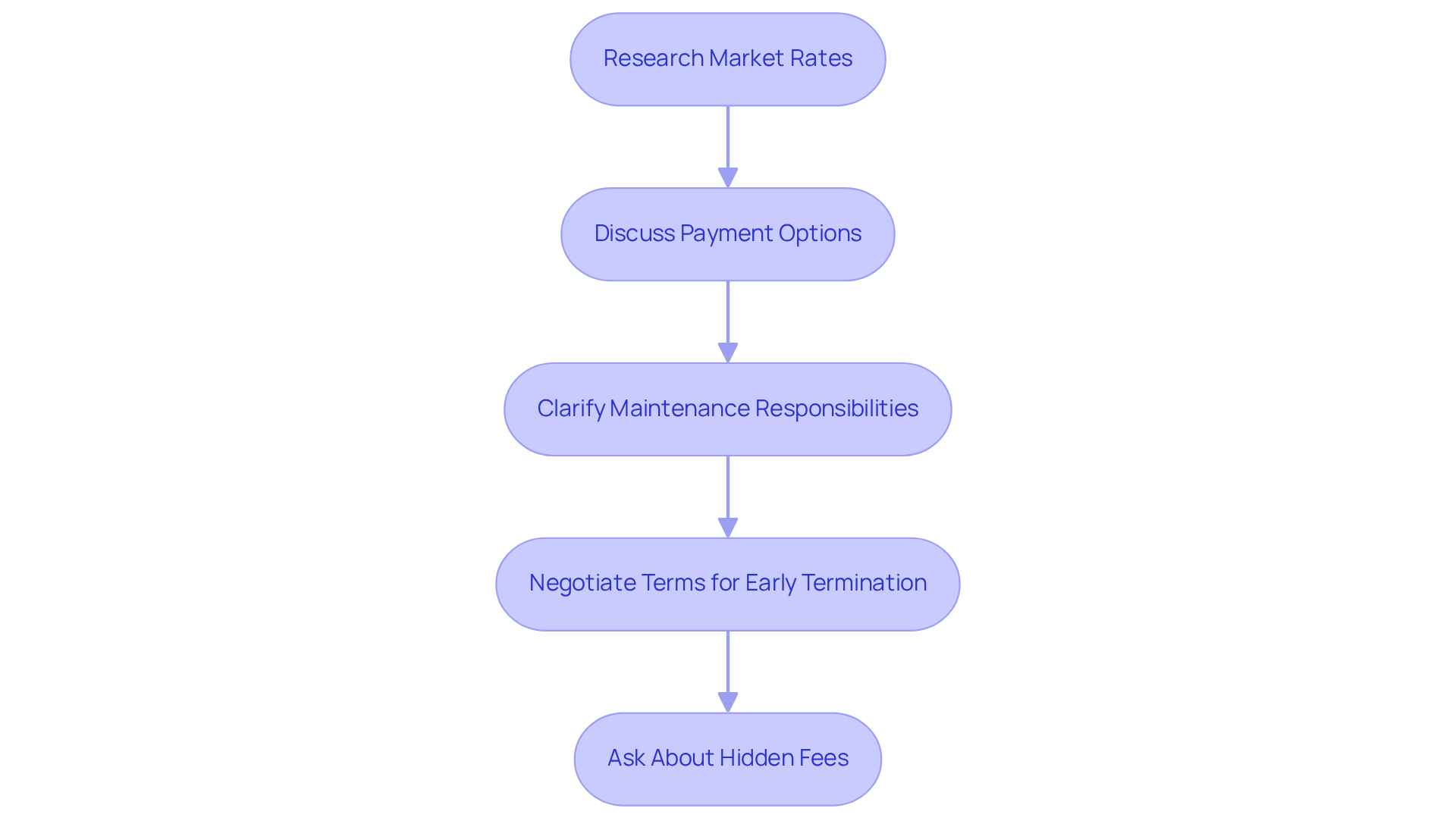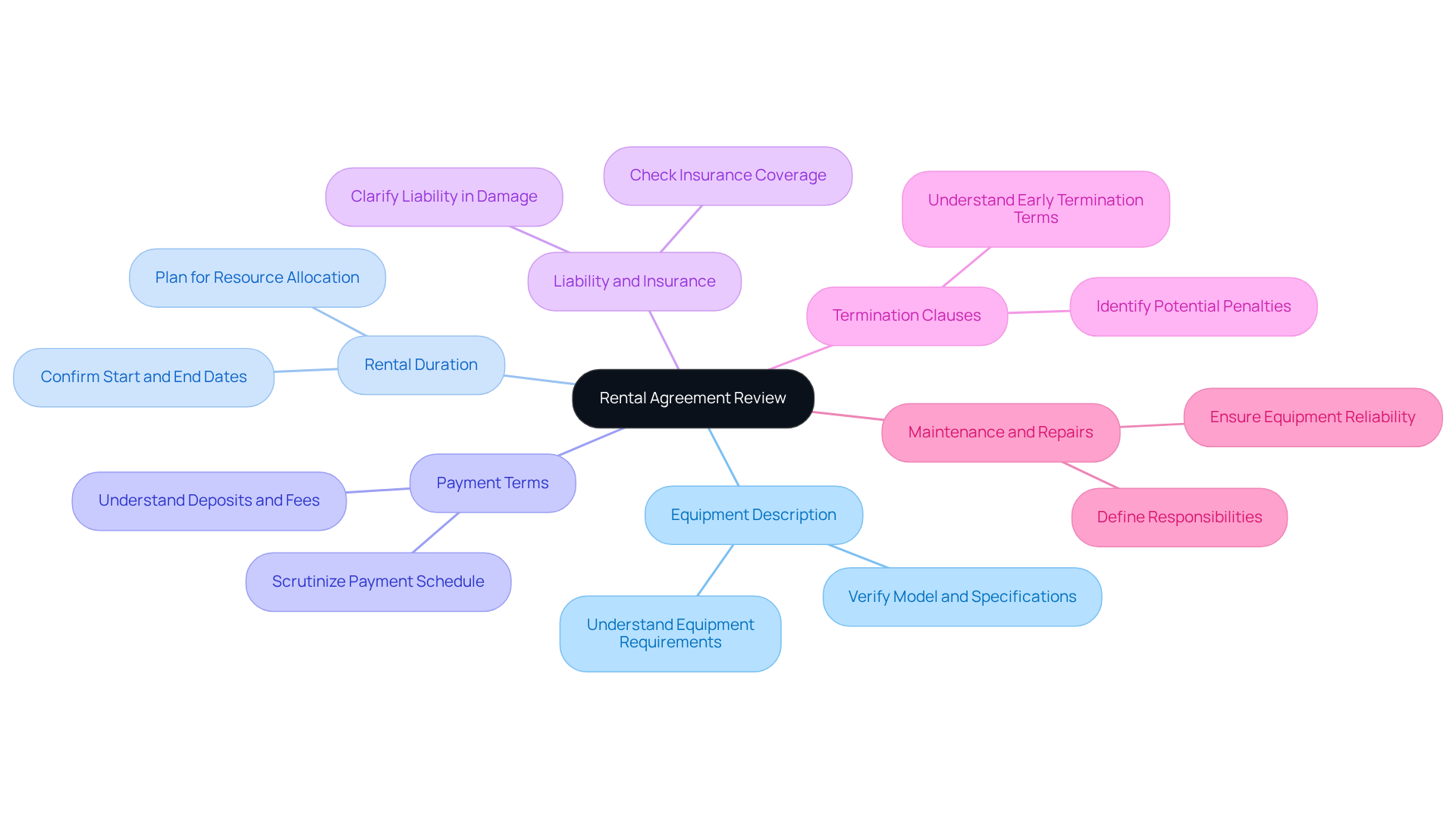Overview
The article presents essential steps to master the backhoe lease process, highlighting significant advantages such as cost savings, flexibility, and access to modern equipment. It elaborates on key factors to consider when leasing, including effective negotiation strategies for securing favorable terms. Furthermore, it underscores the critical importance of thoroughly reviewing rental agreements, which not only helps avoid misunderstandings but also ensures financial protection. By adhering to these guidelines, readers can navigate the leasing landscape with confidence and clarity.
Key Highlights:
- Leasing a backhoe allows for significant cost savings, requiring lower initial payments compared to purchasing.
- Flexibility in lease duration enables payment only for the equipment when needed, enhancing cash flow management.
- Leasing provides access to the latest equipment models, often including maintenance services.
- Key factors for leasing include task requirements, backhoe specifications, budget considerations, rental duration, and terrain conditions.
- Companies can save 30-50% of total ownership costs by opting for a backhoe lease, reflecting a growing trend in the construction industry.
- Negotiating favourable lease terms involves researching market rates, discussing payment options, clarifying maintenance responsibilities, and understanding potential hidden fees.
- Thoroughly reviewing rental agreements is crucial, focusing on equipment description, rental duration, payment terms, liability, termination clauses, and maintenance responsibilities.
Introduction
Navigating the complexities of backhoe leasing can significantly impact construction projects, presenting a cost-effective alternative to the purchase of expensive equipment. This guide explores the essential steps to master the backhoe lease process, emphasizing the financial advantages and flexibility that leasing offers.
However, with numerous factors to evaluate and negotiate, how can one ensure they secure the best lease terms while steering clear of common pitfalls? In addition, understanding the nuances of leasing can empower you to make informed decisions that enhance project efficiency and cost management.
Understand Backhoe Leasing Basics
A backhoe lease presents a strategic solution for construction tasks, enabling you to utilize essential equipment without incurring the substantial initial costs associated with purchase. The key benefits of leasing are manifold:
- Cost Savings: Leasing typically requires lower initial payments compared to outright purchases, facilitating improved cash flow management. For example, a construction company may choose a backhoe lease for around $2,000 per month rather than facing a one-time expense of $150,000. Additionally, leasing aids in preserving cash flow by financing depreciating assets, which is crucial for maintaining financial stability in your operations.
- Flexibility: You have the ability to tailor the lease duration to match your project timeline, ensuring you only pay for the equipment when it is needed.
- Access to Latest Equipment: Leasing affords the opportunity to utilize the latest models, boosting efficiency and productivity without the long-term obligations of ownership. Some leasing agreements even include maintenance services, which can reduce costs and ensure that the equipment remains in peak condition.
As you navigate the leasing process, it is essential to grasp terms such as 'lease duration', 'monthly payments', and 'maintenance responsibilities'. This understanding will empower you to make informed decisions and maximize the benefits of a backhoe lease for your construction needs. With the construction equipment rental market in the United States projected to grow at a CAGR of 4.66% from 2025 to 2033, now is an opportune time to consider leasing as a viable option for your projects.

Evaluate Key Factors for Leasing a Backhoe
When evaluating key factors for leasing a backhoe, it is essential to consider the following:
-
Task Requirements: Assess the scope of your project. Will you be digging, lifting, or moving materials? Understanding the specific tasks will aid in determining the most suitable backhoe model.
-
Backhoe Specifications: Identify the size and power necessary for your undertaking. Larger projects typically require more robust models, as they can handle heavier loads and more demanding tasks. The average backhoe utilized in construction has a digging depth of approximately 14 feet and a bucket capacity of 1 cubic yard, making it adaptable for various applications.
-
Budget: Set a budget that encompasses not only lease payments but also potential maintenance and operational expenses. Companies that choose a backhoe lease can save around 30-50% of the total cost of ownership, establishing it as a financially sound option. The global construction machinery leasing market is projected to reach USD 280.13 billion by 2030, highlighting the increasing significance of equipment leasing in the industry.
-
Rental Duration: Determine how long you will require the backhoe. Short-term projects may benefit from daily or weekly agreements, while longer projects could necessitate a backhoe lease with monthly terms. The average rental duration for construction equipment is about two weeks, and it's noteworthy that 84% of construction companies in the U.S. opt to rent equipment rather than purchase, reflecting a significant trend towards rental solutions.
-
Terrain and Conditions: Evaluate the type of landscape where the excavator will be used. Certain models are better suited for rough or uneven ground, which can greatly affect performance and efficiency. For instance, excavators designed for rugged terrain often feature enhanced stability and traction, crucial for safe operation in challenging conditions.
As Josh Nickell, Vice President of the American Rental Association, emphasizes, "You can’t just assume that there’s a piece of equipment on your lot or hope one will be back in time; you have got to do a lot more planning, and use analytics to forecast what your needs are going to be." By thoroughly evaluating these factors, project managers can ensure they select the appropriate excavator for their specific needs, maximizing both performance and cost-efficiency.

Negotiate Favorable Lease Terms
To negotiate favorable lease terms for backhoe rentals, consider the following steps:
-
Research Market Rates: Familiarize yourself with the typical leasing expenses for the specific excavator model you require. In 2025, the construction equipment leasing market is projected to reach approximately $110.55 billion, indicating a competitive landscape. Understanding these rates will empower you during negotiations. According to EquipmentWatch, the average backhoe lease rates can vary significantly based on model and region, making it essential to gather this data.
-
Discuss Payment Options: Explore various payment structures, such as monthly versus weekly payments. Many rental companies offer discounts for extended lease periods, which can significantly reduce overall costs. For example, recent trends indicate that companies offering longer lease terms may provide discounts of up to 15%.
-
Clarify Maintenance Responsibilities: Establish who will handle maintenance and repairs throughout the lease. This clarity can prevent unexpected expenses and ensure the equipment remains in optimal condition. As Josh Nickell, Vice President of the American Rental Association, notes, understanding maintenance responsibilities is vital for managing costs effectively.
-
Negotiate Terms for Early Termination: Discuss the possibility of ending the lease early if schedule timelines shift. Flexibility in this area can save costs and adapt to changing project needs. Case studies demonstrate that firms negotiating early termination options often save on unnecessary leasing fees.
-
Ask About Hidden Fees: Be proactive in identifying any additional costs that may arise, such as delivery fees or insurance requirements. Understanding the full financial picture will help you avoid surprises later on. Research indicates that concealed charges can accumulate to 10% of the overall leasing expense, making it crucial to clarify these details beforehand.
By following these steps, you can secure a backhoe lease that meets your project needs while optimizing costs.

Review and Understand the Rental Agreement
Before finalizing a rental agreement for a backhoe, it is essential to thoroughly review the following components to avoid disputes and ensure a smooth leasing experience.
- Equipment Description: Verify that the backhoe model and specifications align with your requirements and prior discussions. Understanding equipment specifications is vital for successful backhoe lease outcomes, as noted by industry experts.
- Rental Duration: Confirm the exact start and end dates of the lease to avoid misunderstandings. Clear timelines are crucial for effective planning and resource allocation.
- Payment Terms: Scrutinize the payment schedule, including any deposits, late fees, or additional charges that may apply. A comprehensive understanding of financial obligations prevents unexpected costs.
- Liability and Insurance: Understand your liability in the event of damage or accidents, and clarify whether insurance coverage is included in the leasing agreement. This knowledge is critical for financial protection.
- Termination Clauses: Pay attention to terms regarding early termination, including any penalties that may be incurred. Knowing these details can save you from costly repercussions.
- Maintenance and Repairs: Clearly define who is responsible for maintenance and repairs during the leasing period. Establishing these responsibilities upfront fosters accountability and ensures equipment reliability.
Comprehending these factors is crucial, as disagreements regarding backhoe lease agreements can lead to substantial expenses and difficulties. In fact, statistics indicate that a considerable percentage of lease agreement disputes arise from misunderstandings regarding these key components. As the leasing sector continues to evolve in 2025, the significance of transparency in contracts is increasingly highlighted, with a rising trend towards adaptability and affordability in leasing solutions. Understanding equipment specifications and rental terms remains vital for successful leasing outcomes, as emphasized by industry experts.

Conclusion
Leasing a backhoe represents a strategic decision that significantly enhances operational efficiency while effectively managing costs. By opting to lease instead of purchase, construction companies can enjoy reduced initial expenses, increased flexibility, and access to the latest equipment. Understanding the nuances of the leasing process is essential for maximizing these advantages and ensuring smooth project execution.
When leasing a backhoe, key factors to consider include:
- Assessing task requirements
- Understanding specifications
- Setting a budget
- Evaluating terrain conditions
Additionally, negotiating favorable lease terms, clarifying maintenance responsibilities, and thoroughly reviewing rental agreements are crucial steps that can prevent costly misunderstandings. By taking these steps, project managers can secure a lease that aligns with their specific needs, optimizing both performance and cost-efficiency.
Embracing the backhoe lease process not only facilitates better financial management but also positions companies to adapt to evolving project demands. As the construction equipment leasing market continues to expand, leveraging these insights will be vital for making informed decisions. Whether through negotiating better terms or comprehending rental agreements, a proactive approach to leasing can significantly enhance project outcomes and overall business success.
Frequently Asked Questions
What is a backhoe lease?
A backhoe lease is a strategic solution for construction tasks that allows you to use essential equipment without the substantial initial costs associated with purchasing it.
What are the key benefits of leasing a backhoe?
The key benefits of leasing a backhoe include cost savings, flexibility in lease duration, and access to the latest equipment. Leasing typically requires lower initial payments, helps preserve cash flow, and may include maintenance services.
How does leasing help with cash flow management?
Leasing requires lower initial payments compared to purchasing, which helps improve cash flow management. For example, a construction company might lease a backhoe for around $2,000 per month instead of facing a one-time expense of $150,000.
Can I customize the lease duration for a backhoe?
Yes, you can tailor the lease duration to match your project timeline, ensuring you only pay for the equipment when it is needed.
What advantages does leasing provide in terms of equipment access?
Leasing allows you to utilize the latest models of equipment, boosting efficiency and productivity without the long-term obligations of ownership.
Are maintenance services included in backhoe leasing agreements?
Some leasing agreements may include maintenance services, which can help reduce costs and ensure that the equipment remains in peak condition.
What should I understand when navigating the leasing process?
It is essential to grasp terms such as 'lease duration', 'monthly payments', and 'maintenance responsibilities' to make informed decisions and maximize the benefits of a backhoe lease.
What is the outlook for the construction equipment rental market in the U.S.?
The construction equipment rental market in the United States is projected to grow at a CAGR of 4.66% from 2025 to 2033, making it a viable option to consider for your projects.




